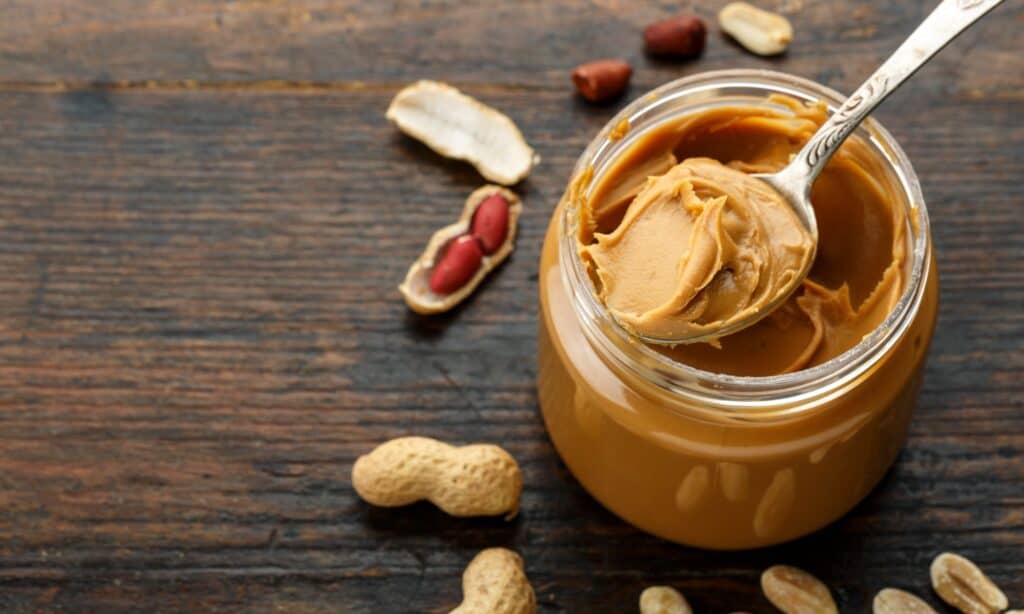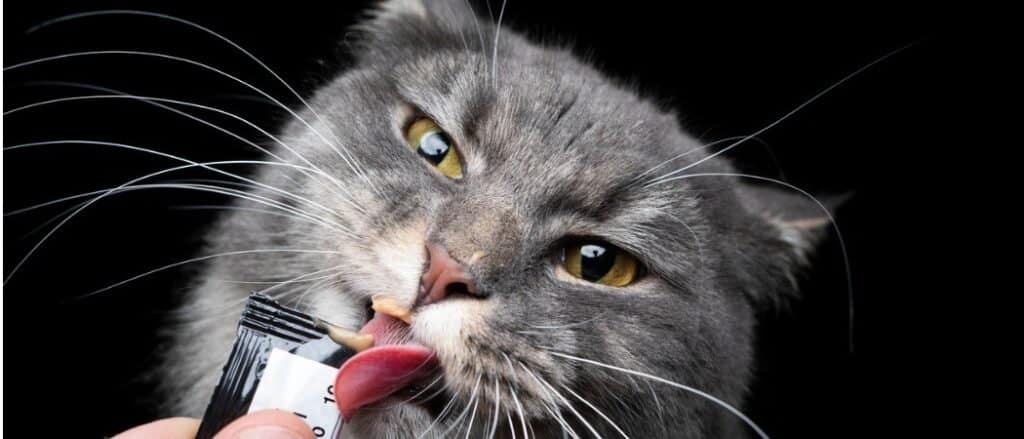It’s a scenario many cat owners will be familiar with: You’re minding your own business, having something to eat. Suddenly your feline friend turns up, sniffing the air and curious about this interesting thing you’re eating. Unable to resist those big pleading eyes, you present the cat with a small sample. The cat licks it off your fingertip so fast you can’t even see its tongue. So you offer another dollop. And then you wonder, should I be doing this? Can cats eat peanut butter?
What to Know About Your Cat’s Taste for Peanut Butter

I can has peanut butter? Your can may enjpy PB, but that doesn’t mean it’s a safe treat.
©iStock.com/Sanny11
Cats are meat eaters. Their bodies need protein from animal products for a strong heart, good vision, and overall health. So most of your cat’s diet should come from nutritionally complete commercial cat food. That said, cats can enjoy the taste of other kinds of food, and for some that includes peanut butter. Though cats can’t taste sweet flavors, it could be they enjoy peanut butter’s saltiness or creamy texture. So should you share your PB? Here’s what you need to know.
1. Cats Can Eat Peanut Butter, but Probably Shouldn’t.
Even if they like the taste, peanut butter has no nutritional value for cats. As mentioned, cats need to eat meat; their digestive system isn’t set up to draw nutrition from peanuts. I mean, they’re not elephants. Though come to think of it elephants don’t actually eat peanuts, so bad example. Anyway…strictly speaking, peanuts aren’t harmful to cats, but some peanut butter has other ingredients that could be problematic. (More about that in a moment).
2. Keep any PB sharing to Small Amounts.
Cats are famous for their idiosyncrasies. So maybe the furry little weirdo you live with has a huge hankerin’ for peanut butter, and won’t let you alone whenever you’re enjoying your PB&J. If, for whatever reason, you feel that peanut butter needs to be a part of your cat’s life, keep it to a minimum. The vets of Vetrenarians.org recommend that cats eat no more than half a tablespoon of peanut butter twice a week. Only 10% of a cat’s calories should come from treats, and peanut butter is a high-calorie food. The high sodium content of peanut butter is also unhealthy.
3. Watch for Problem Signs.
Some cats don’t handle peanut butter well, no matter how much they may enjoy eating it. Watch for signs of choking or of gastrointestinal distress (vomiting, diarrhea, etc.). Like people, cats can have peanut allergies, so be alert for itching, hives, or swelling after feeding peanut butter to your pet. An allergic reaction can be fatal, so seek emergency care.
4. Check the Label.
The ingredients in peanut butter can vary from one brand to the next. Never feed your cat peanut butter, or anything else, that contains the artificial sweetener xylitol. A sweetener used in place of sugar, xylitol is poisonous to cats. Some food preservatives are unsafe for cats as well. Also avoid brands that are high in calories, sodium, or sugar, or that contain trans fats. Givena ll that, the next best thing to not feeding your cat any peanut butter is to choose a brand that only has one ingredient: peanuts.
5. Try Cat Treats Instead.

A treat that’s formulated specifically for cats is a much better choice.
©iStock.com/Nils Jacobi
Your instinct to give treats to your cat is a good one. Sharing tasty edibles with our pets helps strengthen our bond with them. Treats also work well as rewards for good behavior and can help calm down a stressed pet (if you’ve ever dug into a pint of cookie dough ice cream after a hard day at work, you get the idea). Instead of peanut butter, opt for a commercial cat treat that won’t contain unsafe or problematic ingredients. If your cat has special dietary needs, or you want guidance on choosing a safe and healthy treat, consult with your veterinarian. Want to go the extra mile and create your own cat treats? VCA Animal Hospitals has a simple recipe you can try. Whatever treats you share, remember to keep them to no more than 10% of your cat’s calories.
5. Some Human Food Can Be Good Treats for Cats.
Maybe it’s the act of sharing your own food with your pet that makes a PB moment feel so special. If that’s your jam, try switching to food that’s as safe for them as it is for you. Just remember that these are occasional treats, not a regular part of the cat’s diet.
- Small amounts of cooked beef, chicken, or turkey. These feline favorites are sure to please. Never give your cat raw or spoiled meat or any meat you wouldn’t eat.
- Whole grains. Some cats have a taste for grains. Polenta is great for cats who like corn; you can also cook and mash oats, brown rice, barley, millet, and couscous. Do cook them, otherwise your cat will have trouble digesting the grains.
- Fish, canned or cooked. Never feed your cat raw fish, including sushi.
- Eggs should also be cooked before you give them to your cat.
- Cheese is an okay treat in small amounts. Many cats aren’t good with digesting dairy, so be sure not to overdo it.
The photo featured at the top of this post is © Irina oxilixo Danilova/Shutterstock.com
Thank you for reading! Have some feedback for us? Contact the AZ Animals editorial team.







